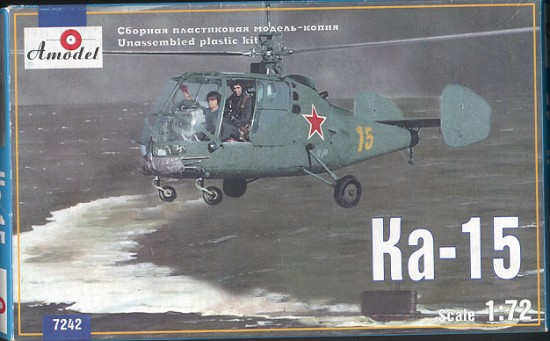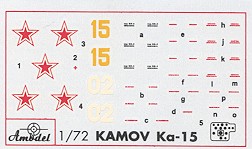
| KIT: | A-Model 1/72 Kamov Ka-15 |
| KIT #: | 7274 |
| PRICE: | $ |
| DECALS: | Three options |
| REVIEWER: | Scott Van Aken |
| NOTES: |

| HISTORY |
The Ka-15 made its first flight on April 14, 1953. State acceptance trials were completed in 1955 and the next year the helicopter entered production at aircraft factory #99 at Ulan-Ude. The Ka-15 evolved into a number of specialized versions. This includes the multi-purpose Ka-15M, the UKa-15 dual control trainer and the four seat Ka-18. In each case, prototype constructions began at factory #82 in Tusyhino and was completed at the OKB's own experimental shop near the Ukhtomskaya railway station.
By virtue of its small size and maneuverability, the Ka-15 successfully performed take-offs and landings on small ship's helipads, even in State 6 sea conditions. Used as an ASW platform, once a sub was detected by two of the helicopters, a third was sent out with 50 kg depth charges. The Ka-15 and variants remained in service for nearly 20 years before being supplanted by the Ka-25 Hormone.
| THE KIT |
 Opening the box, one is presented with three sprues of plastic, well
protected in double bags. Upon removal from the bags, you then see that
there are two dirty white and one clear sprue. There is flash of some level
on all the parts so clean-up is mandatory, even on the tiniest pieces, of
which there are quite a few. The clear bits are well molded, but rather
thick so any heavy detailing of the interior will not be seen to level that
one likes. The rest of the parts are well molded and free of sink areas or
ejector pin markings of any kind. There does seem to be some sort of
residue on the pieces so I assume this to be a mold release agent. If so,
it is advisable that the kit be washed in warm, soapy water before
construction to remove this agent.
Opening the box, one is presented with three sprues of plastic, well
protected in double bags. Upon removal from the bags, you then see that
there are two dirty white and one clear sprue. There is flash of some level
on all the parts so clean-up is mandatory, even on the tiniest pieces, of
which there are quite a few. The clear bits are well molded, but rather
thick so any heavy detailing of the interior will not be seen to level that
one likes. The rest of the parts are well molded and free of sink areas or
ejector pin markings of any kind. There does seem to be some sort of
residue on the pieces so I assume this to be a mold release agent. If so,
it is advisable that the kit be washed in warm, soapy water before
construction to remove this agent.
This is not a large kit, but it is
quite well detailed. The interior includes two seats, an instrument panel,
collective and cyclic for the pilot, rudder pedal and a center console. The
rotor head mechanism is quite complex looking with a number of small rods
in each of the two rotor assemblies. Once together, I'm sure they
will be quite strong. Gluing these bits will take some care as the plastic
appears to be a bit on the soft side so 'hot' glues that most of us use
will have to be used sparingly. No nose weight info is provided and I'd be
quite surprised if none is needed. Finding places to put it, however will
be a challenge as only a tiny space beneath the floor is available.
Instructions are fine of the kit with five well drawn construction sequences. Color information is provided with generic and Humbrol references. Much of it is shades of grey. That extends to the exterior of the helo as well with all three in an overall 'Slate Grey', differentiated only by fuselage number (or lack of it). There is an excellent color photo on the box top that will help a great deal when building and painting this kit. Decals are what one normally expects from a Russian kit company in that they are quite matte and have a somewhat large carrier film. My experiences with these kinds of decals are mixed as more often than not, they give me some trouble. This is either by breaking up, or not doing well with setting solutions and silvering. However, not having built an A-Model kit, I'll reserve judgment until I actually get around to using them.
| CONCLUSIONS |
You know, it is great to live in a time when we have so many options when it comes to building models. 20 years ago, I'd never have thought that we'd be blessed with such largesse. Sure, much of that largesse will not be easy to build and I'm sure this kit falls into that category, but it is great that we have the choice.
| REFERENCES |
Kit instructions.
If you would like your product reviewed fairly and quickly by a site that has nearly 300,000 visitors a month, please contact me or see other details in the Note to Contributors.